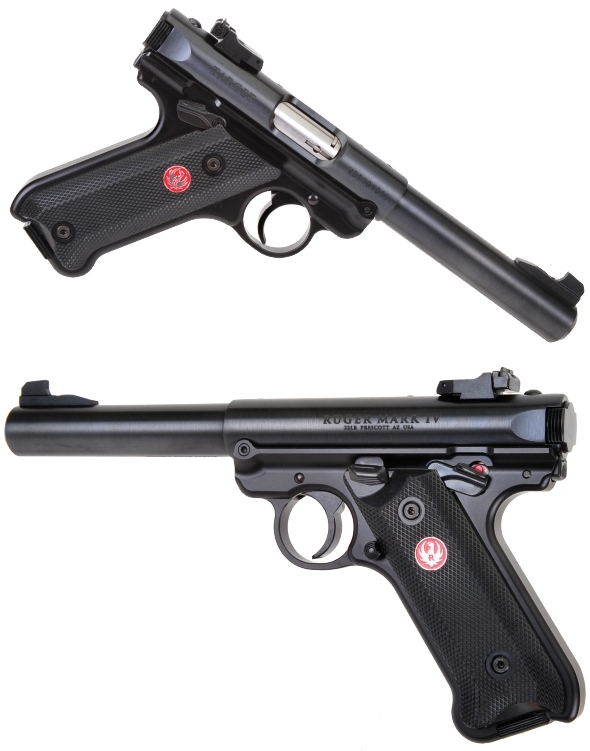
If there was a Ruger philosophy represented by the launch of the new Ruger Mark IV Target pistol, it would have to be “Keep improving and listen to customers”. While the Mark IV bears many outward similarities to the highly successful Mark III series, the Mark IV’s refined design brings with it significant improvement. Examples? Sure.
-
Field stripping is accomplished with a one touch button at the rear of the frame; the barrel and receiver tip down and lifts off and the bolt pulls free of the receiver. No tools required.
-
The new one piece grip frame is CNC machined from a solid piece of aluminum.
-
The hammer, sear, bolt and firing pin are all refined pieces.
-
The bolt stop has been reshaped for easier operation, the little Mark III thumb safety numb has been replaced with a more traditional ambidextrous thumb safety.
-
The magazine release has been extended and magazines now drop free when released.
-
The Mark III loaded chamber indicator is gone, as is the internal key lock.
-
The Mark IV maintains compatibility with Mark III sights, scope mounts and magazines.
-
The one piece barrel/receiver assembly and internal bolt design is retained.
The results of the changes, retentions and omissions in the move from the Mark III to the Mark IV is a smoother functioning pistol, improved reliability and ease of routine maintenance. The Mark III pistol grew into over sixty distinct configurations. For now the Ruger Mark IV is beginning with three, the subject pistol model number 40101 and a Hunter version model 40118.
|
Ruger Mark IV Pistol |
|||
|
Company |
Sturm, Ruger & Company, Inc. | ||
| Point of Manufacturer | Prescott, AZ U.S.A. | ||
| Model # | 40101 | 40103 | 40118 |
| Description | Mark IV Target | Mark IV Target | Mark IV Hunter |
| Type of Action | Autoloader SA | ||
| Caliber | 22 Long Rifle | ||
| Magazine Capacity | 10 | ||
| Barrel Length | 5.50″ | 5.50″ Bull | 6.88″ Fluted |
| Barrel Material | Alloy Steel – Blued | Stainless Steel | Stainless Steel |
| Barrel Contour | Bull – Blued | Bull – Satin | Bull – Satin |
| Rifling Twist Rate | 1:16″ | ||
| Receiver Material | Alloy Steel | Stainless Steel | Stainless Steel |
| Grip Frame Material | Aluminum | Stainless Steel | Stainless Steel |
| Frame Finish | Black Anodized | Natural – Satin | Natural – Satin |
| Grips | Checkered Plastic | Checkered Plastic | Checkered Laminate |
| Front Sight | Undercut Blade | ||
| Rear Sight | Adjustable W/E | ||
| Weight of Firearm | 35.50 Oz. | 42.35 Oz. | 42.35 Oz. |
| Overall Length | 9.75″ | 9.75″ | 11.12″ |
| Overall Height | 5.50″ | 5.50″ | 5.50″ |
| Width | 1.20″ | 1.20″ | 1.20″ |
| Manual Safety | Thumb – Ambidextrous | ||
| Magazine Disconnect | Yes | ||
| Loaded Chamber Indicator | No | ||
| Key Lock | No | ||
| CA/MA Approved | No | ||
| MSRP | $499 | $629 | $729 |
Again, but now with a little more blah, blah, blah… and pictures
In 1949 Bill Ruger and Alex Sturm, on a fifty thousand dollar capital investment from Sturm, pulled the pieces of Ruger’s original company out of receivership and created Sturm, Ruger & Company. The first product introduced was a blow back 22 rimfire pistol, the Ruger Standard, which was joined by the Ruger Mark I target pistol. That original models persevered in numerous configuration until 1982 when they were displaced by the Mark II. The major changes from Mark I to Mark II were: The bolt remained opened after the last round from its magazine was fired, magazine capacity was increased to 10 rounds from 9, the magazine latch was refined, the pistol could be loaded or unloaded with the safety “on”, and the rear of the receiver was scalloped to facilitate grasping the bolt cocking lugs.
The major changes from the Mark II to the 2005 Mark III were: one extra “I”, the sights and ejection port were re-contoured, the magazine release was moved from the grip bottom to the frame’s left side, a visible and tactile loaded chamber indicator was added to the left side of the receiver, a key actuated internal lock was added and a magazine disconnector was added. The latter three, according to some Internet message board denizens, signaled Ruger’s compact with Beelzebub, the Price of Darkness, Lucifer, or the Evil One. If there was such a pact, it was broken with the Mark IV.
Below, some of the exterior changes made in moving from the Mark III (Top) and Mark IV (Below).
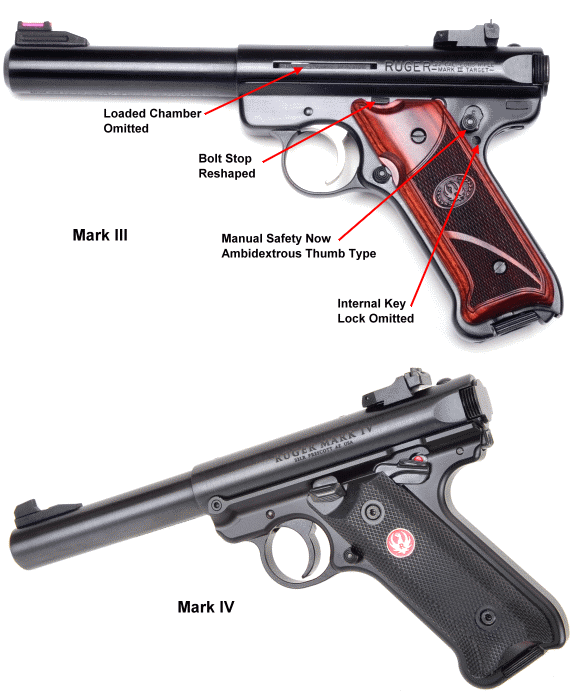
I think the side by side comparison does a good job of illustrating how clean the lines are on the Mark IV and how much improvement was made in control layout and form.
Quashing the Mark III disassembly conundrum…
I can’t remember a time, when discussing the Ruger Mark III’s excellent performance, that I wasn’t interrupted by a someone jumping up and down and waving their arms and shouting, “They are impossible to disassemble and reassemble”. This always leaves me picturing millions of Ruger Mark IIIs owned by consumers, all hopelessly in pieces on kitchen tables, with a question mark embraced within thought bubbles above each respective owner’s head. Then I picture the person who raised the issue, standing in front of a closed door, perplexed and unable to fathom how it might be opened.
The new Mark IV disassembly instructions, after removing magazine and chamber checking for empty – Engage safety, depress the take-down button at the back of the grip frame (See thumb), rotate barrel/receiver downward on the frame front pivot pin until it clears the vertical bolt stop pin and lift off. Remove the internal bolt by pulling it out of the receiver. To reassemble, reverse.

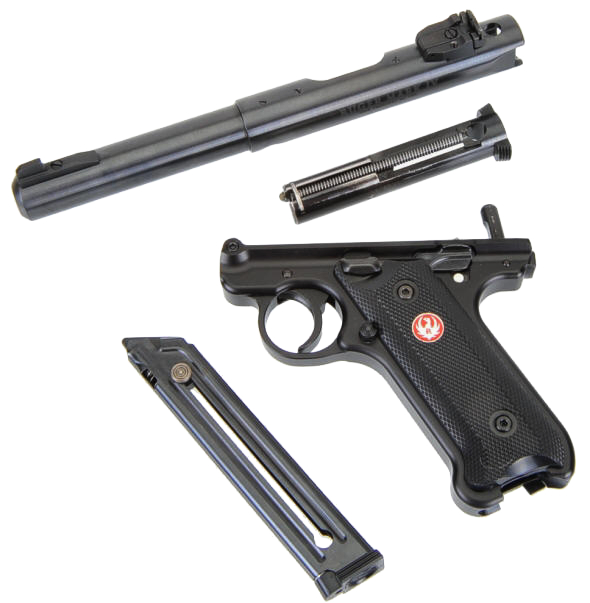
Moving in the same circles…
The Mark IV’s bull barrel is threaded into its cylindrical receiver, its internal bolt is also cylindrical… a whole lot of concentric circles that leads to a high degree of rigidity and accuracy. The barrel is fixed, the receiver is fixed, the sights are fixed. Only the bolt moves inside of the receiver.

The Mark IV is adaptable. The top of the receiver is drilled and tapped to mount conventional optical and electronic sighting devices. At only 1.2″ in width, the Mark IV is comfortable to carry. The controls on the Mark IV really are better formed and arranged than on the Mark III, all easy to swipe, poke or push without excessive stretching or loosening of grip. A little relief cut into in the grip at magazine release would be helpful. What can I say? Freakishly short and stubby thumbs.
The only control that requires a little thought is the ambidextrous safety, but that depends on shooting styles and personal preferences. I found that, in a high firm grip, disengaging the safety by pushing down on the left safety with the ball of the thumb, pushed the right hand side safety up against the side of my hand shooting hand, interfering with full travel. This doesn’t occur with a 1911 because the front of the safety pivots up and down while the Ruger travel is at the rear. It took about 10 seconds to alter my methodology to make the standard set up work for me.
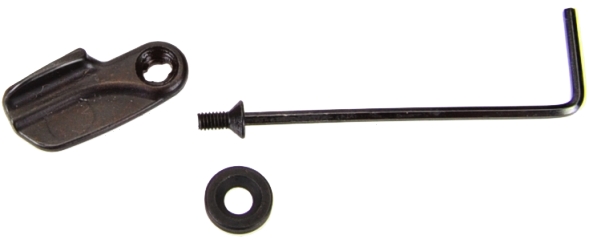
For folks who might be less adaptable and might resent the presence of the right side safety ears, Ruger includes a black steel bushing that replaces the right side thumb piece. The bushing sets the spacing for the safety cross shaft and fills the gap between the grip and frame with the right side thumb piece normally would reside. Install is easy; pull the right grip, remove the countersunk machine screw, substitute the bushing, reinstall the grip panel.
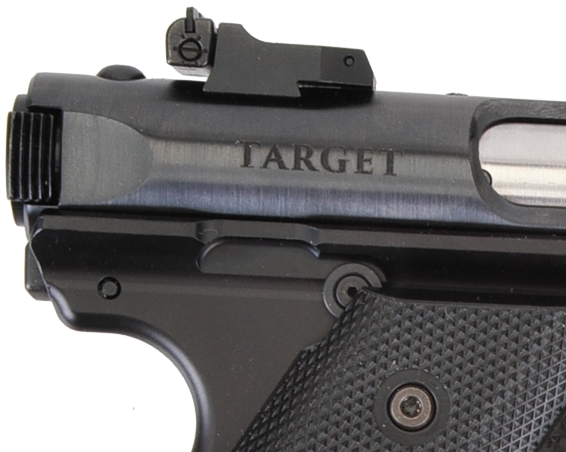
Shooting impressions….
Experience gained with earlier versions of the Ruger would not be wasted on the Mark IV. The combination of a swept grip angle and bull barrel of this length places the pistol’s center of gravity under the trigger, rather than the typical nose heavy feel of a bull barrel pistol. Extending a shooting hand, the sights level and fall naturally on a target. The grip angle measured from bore centerline and down through both grip screws is 120º and the same angle for both front and back straps. It is a very comfortable grip with support for all fingers and a shape that draws the hand into a high and secure hold without forcing the trigger finger into an odd angle. Neato.
Six types of ammunition were used for velocity and accuracy testing. Shooting was done with individual types of ammo, mixed types and with subsonic as last round in the magazine to test for stay open reliability. There were no failures of any type.

| Ammunition | Bullet Weight Grains |
Bullet Type |
Mfg Rated FPS |
Ruger Actual FPS |
50 Ft 5 Shot Group” |
| Remington Cyclone | 36 | HP | 1280 | 1134 | 1.0 |
| Eley Subsonic | 40 | RN | 1040 | 952 | 0.7 |
| Remington Golden Bullet | 40 | RN | 1255 | 1059 | 0.5 |
| Remington Thunderbolt | 40 | RN | 1255 | 1133 | 0.9 |
| Peters | 40 | RN | 1255 | 1027 | 0.5 |
| Winchester Super Speed | 40 | RN | 1300 | 1075 | 0.7 |
|
Chronograph 10′ from muzzle – Groups shot from a sandbag rest |
|||||
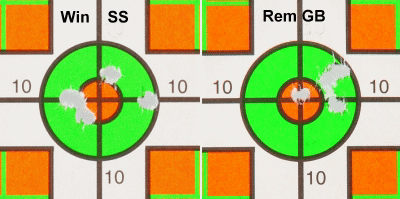
Accuracy was excellent, with little effort required. The Mark IV was shot using a couple of sandbags for a rest, but it also shot well from a two handed hold. The sight set proved to be very good. While unadorned with dots, light pipes, beacons or flashing turn signals, they stood in contrast against a target, adjustment was precise and they stayed put in use. Magazines are easy to load and they do pop out cleanly when released. Bolt retraction effort is distinctly light. Trigger pull, measured after only a few rounds, checked 5 lbs 8 oz with just a smidgeon of take up followed by a clean release. Right now, more shooting.


Email Notification